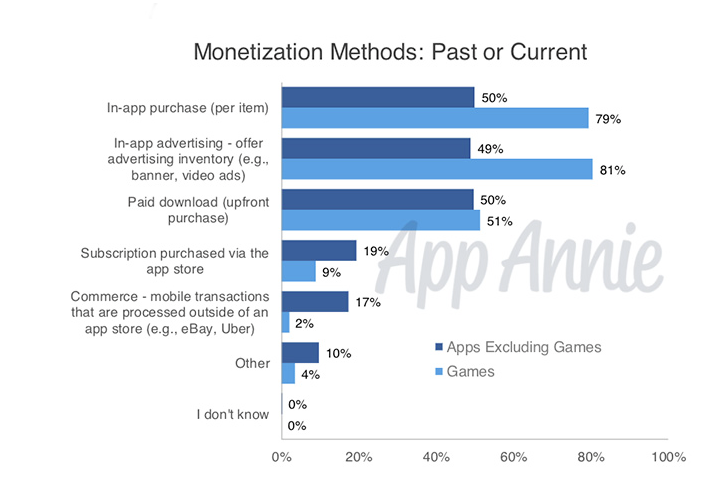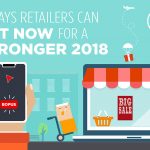For media, entertainment and gaming companies, figuring out how to make money with a mobile app is a big part of the Strategy phase of the mobile lifecycle. Mcommerce apps that sell products directly have that part figured out too. Naturally enough, this is referred to as “monetization” and these companies spend a whole lot of time and effort strategizing around it.
If you’re in another line of work, however, you may only be thinking of mobile as a marketing channel or as a utilitarian tool for things like wayfinding, property management, or simply sharing helpful information. If that’s the case, you’re leaving money on the table.
What Is an App Monetization Strategy?
Simply put, it’s a plan for driving revenue via your mobile app, using one or a combination of different app monetization models. It’s best to consider and plan for monetization during the Strategy phase, so you don’t have to force-fit something later.
Outside of direct mCommerce, there are five basic options:
- Pay-to-download (or “Paid”): Pretty straightforward. These are apps that you pay $X to download.
- Subscription: Users pay a monthly fee via the app stores.
- Free (“Freemium”) with in-app purchases: The app is free to download but the publisher makes money on in-app purchases that provide an enhanced, “premium” experience. In games, these are usually micro-transactions such as special gear, extra lives, weapons, gaming levels, etc. In other types of apps, these could be access to exclusive content behind a paywall.
- Limited Freemium: The app is free to download but is limited in one of two ways—either the user can access full functionality for a short time only OR the free version only offers basic functionality, such as a few game levels. The idea is to entice users to try before they buy, hoping the app experience is compelling enough to convert them to a fully paid or subscription version.
- Free to download, with advertising: In-app advertising is an increasingly common way to monetize all types of apps. Users will welcome ads if they are well-targeted, relevant, interesting and non-disruptive to the user experience. It’s even better if the advertising adds value by connecting users with rewards or exclusive content (as in sponsored gameplay integrations).
According to App Annie’s recent worldwide survey of app professionals, in-app purchases and in-app advertising were the most popular monetization strategies, however many of those surveyed expected subscription and mCommerce to become more popular over time.
Developing a Sound Monetization Strategy
There is no cut-and-dried monetization strategy that works for every industry or every type of app. Ultimately, your team will determine the type(s) of monetization you want to include in your app by carefully evaluating a number of considerations, including:
- Your app experience: User experience (UX) should be your most important consideration. Any monetization strategy you choose should align with the overall experience and preferably enhance it.
- Your audience: Across various demographic categories, people feel differently about paying for an app or making in-app purchases, and their behavior varies accordingly. According to Gartner, people in the 25-34 age bracket spend the most on both paid apps and in-app transactions (thanks, older Millennials!). Those on the younger side of Gen X (35-44) come in second, but they spend more on in-app transactions than paid downloads. In addition, women spend less overall on paid downloads and in-app transactions—but they’re more likely to try a freemium approach.
- Your business goals: Monetization should always complement your overarching business goals, not take away from them.
- What the competition’s doing: Check out other apps in the same category. How are they monetizing? Does their approach complement or detract from their UX?
Though game developers pioneered it, mobile app monetization is still a developing field. If your team lacks expertise in monetization, consider working with an expert partner. And if in-app advertising may be part of your mix, seek out a monetization partner with not only the requisite experience but also trong brand relationships and robust data sharing. Want to learn more? Download our checklist, 6 Smarter Questions To Ask Your Monetization Partners.










This was a good overview of the various app pricing models. Thanks.
Thanks, Ilene!
Thanks Emily! Great read and suggestions.
Thanks Andrew!
Thanks!!
My educational app will be offered to the private sector(schools) as an extra service for parents and students. I intend to make the school afford the annual cost. What do you suggest, please?
Thanks again!!!
Hello Malik! This is great question that many developers find themselves asking all the time! There are several different models that you could look at:
1. Subscription based model: If you think schools should pay for the annual cost of the app, we recommend analyzing what exactly the school will be getting in return. Are you providing a service or tool that is not offered currently by any other company? If so, what price points are the other companies quoting for these services and tools? If you’re providing something that no other company currently offers, and you’ve proven that schools, students, and the parents of the students are in need of your app, then you have an opportunity to capitalize on this with offering an exclusive, competitive price.
2. Freemium model with in-app purchases: A tried and true method is to provide an app for free with in-app purchases (IAPs). Offer exclusive or additional content within your app for a price that the parents are willing to pay for.
3. Freemium model with ads: Another method is to provide all content for free in the app, but integrate ads in a tasteful manner. If you can estimate how many Daily Active Users the app will have and what the average user session will be, you can start to project revenue from in-app advertising.
Hi Andrew,
I am in a similar boat. We are launching a sports educational app for student athletes but aren’t directly targeting schools yet. Our current model is freemium with in-app purchases. Basically the app is free, there are 5 free topics (that contain 4-5 levels within each topic). Then there are another 10 buttons (that contain 4-5 levels each topic). Our current pricing strategy is that the parent/student/athlete can unlock 1 button or unlock all at a big discounted price (to make it a no brainer).
This is still our MVP, so we feel we need to prove this concept before we move to a subscription model, then we can sell to schools etc at a premium price.
I know it is hard to give an answer, but any feedback on what i proposed would be GREATLY appreciated!
Hey Christopher, that’s an interesting app idea! While it is challenging to understand the ins and outs of your app from where I stand, I’m a big believer in getting feedback from users or potential users. If you haven’t done so already, speak with as many student athletes and parents of student athletes as possible about your app. Ask them if they see value in the things you’re planning to deliver in the app. Would they pay for the “10 buttons” with the content? If they wouldn’t, what type of content would they pay for? Reports indicate that on average ~5% of app users make in-app purchases, so it’s crucial to get feedback from those who do to understand how you can find and engage more of them.
And remember, your app doesn’t have to be absolutely perfect at launch. It has to function without crashing or bugs, but you can let users tell you what they want from your app by watching how they interact with it. Review your app analytics to see where users are spending most of their time and where they drop off. Reach out to those engaged users and see what their feedback is.
Who knows? Maybe those users will give you nuggets of information that completely change your business model. For example, maybe down the line student athletes can leverage their success on the field (points scored, assists given, minutes played, etc.) into in-app currency to purchase these “10 buttons with content” in your app. If these students prove to do better in school, you can make a case to have the school implement the app and promote it to student athletes, therefore increasing your user acquisition.
Just some thoughts…hope these help!
Hello Emily, thanks for sharing this!
Our app is a cycling tracking app that helps cyclists track their record, provides analysis, and also come with tool for planning a cycling event that navigates and collect group information during ride.
We have always thought Freemium the most suitable pricing model for us. However, we are also considering charging based on usage, since you might not join a group ride very often (say twice a month), and in this case, a monthly subscription model may seems a bit pricy. Perhaps a deposit in account and each event cost a certain amount of credit (like what Skype do in their early time)
Please let me know what you think!
Hi Molly, thanks for your comment. I think my comment above applies to your question as well. I would speak with cyclists and see what their reactions would be to being charged for using your app. Of course everyone likes free things, but it’s important to ask the question. Are there competitor apps that don’t charge cyclists to use the features your apps offers? If so, why would a user want to pay to use your app? What’s your app’s core asset or value that would drive someone to pay to use it? Traditionally, sports and fitness-related apps are free with a subscription model tied to upgraded features. Perhaps cyclists are interested in having a feature that provides a statistical analysis of their performance based on their past couple of rides. Or maybe if your app integrates APIs from wearables or Apple’s HealthKit, it can provide further insights to cyclists on the estimated energy output or performance they should expect during their upcoming group ride. Your potential app users (cyclists) should be your best friends right now! What problems or challenges do they currently have, and how can you create a core loop in your app that solves these challenges for them?